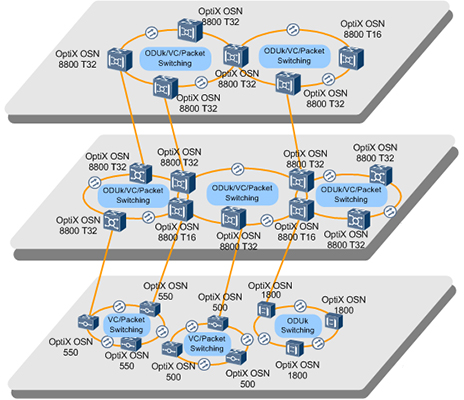The new generation of OTN technology is developed on the basis of the original transmission network. Based on WDM technology,
OTN introduces SDH‘s powerful operation, maintenance, management and assignment (OAM) capability on the basis of large transmission capacity, and makes up for SDH‘s lack of functions and maintenance management overhead when facing the transmission layer. OTN inherits the dual advantages of SDH and WDM, and can avoid a series of problems in traditional systems. At present, OTN has become the most used data transmission technology for broadband customers.
What is an OTN Network?
The term OTN (optical transmission network) is defined by the international telecommunication union telecommunications standardization unit (ITU-T). OTN technology can carry out the transmission, reuse and monitoring of business signals in optical domain, and ensure its performance index and survivability. Many SDH and WDM transmission network functions and system principles can be moved to OTN network.
Although 0TN brings together all the advantages of SDH and WDM network technologies and has the ability to replace SDH and WDM independently, its scale application process is still not perfect, so it is necessary to maintain the coexistence and interworking of OTN, SDH and WDM. In order to realize the coexistence of the three technologies, digital packaging technology in OTN plays an important role. As a new technology in OTN, it can not only achieve efficient management of transport network by "encapsulating" the original data, but also build OTN client (such as SONET/SDH, IP, ATM) connection in the metropolitan and core network.
Five advantages of OTN network
OTN networks combine the advantages of optical and electrical domain processing to provide large transmission capacity for wavelength/sub wavelength, fully transparent connections, and carrier-level protection. Its main advantages are as follows:
(1) Standard hierarchy: the OTN hierarchy includes a multiplexing hierarchy, which defines exactly how a low rate signal will feed into a higher rate payload. This enables the WDM platform to be transferred directly to low rate services within a 10Gbps, 40Gbps, or 100Gbps transmission network without the need for external wavelength demultiplexing and manual interconnection.
(2) Transmission capacity expansion: OTN network can be deployed by operators to use the least network infrastructure, achieve high quality services, for LAN, man and broadband access network to provide high capacity infrastructure.
(3) Cost reduction: OTN network can transmit multiple clients at a single wavelength, and keep its specific requirements, which can reduce the overall transmission cost while ensuring effective bandwidth utilization.
(4) scheduling flexibility: the construction of OTN network can not only support the current network transmission technology, but also according to the needs of the business to prepare for the future, through end-to-end scheduling easily extended to ring network and mesh network.
(5) Transparent transport: transparent transport is very important for service providers providing multi-service delivery. The transparency of
OTN enables the network to host any service, including Ethernet, storage, digital video, and SONET/SDH, without disturbing the timing of the client.


